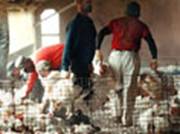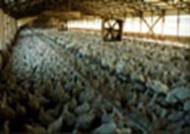
In 1950 in Canada it took 84 days for a broiler chicken (bird raised for meat) to reach the market weight of 1.36 kg, but by 1998, it took only 42 days to produce a 2 kg bird. The time to reach market weight for broilers decreases about one day each year and the trend is expected to continue. Currently, the production time is around 40 days. The spectacular growth rate of broiler chickens has been achieved mainly through breeding for growth in muscle, plus routine use of growth promoting drugs. The fast growth has resulted in sie effects, which cause intense animal suffering such as leg and skeletal deformities, acute death syndrome, and heart attacks. Broiler chickens live in extremely crowded, barren environments. By slaughter, each bird has only a half-square foot (465 sq cm) of space. That’s less than the size of a computer mouse pad. These unnatural, barren, and confining conditions deny animals opportunity to express natural behaviors. Massive amounts of manure accumulate in the floor litter from the thousands of birds during their six-week life. Broiler house lighting is constantly manipulated to simulate higher food consumption and faster weight gain, with lights kept on up to 23 hours straight. Upset circadian cycles cause distress, which humans know as jet lag. “Broiler breeders”, the parent birds kept to give birth to broiler chickens, suffer a deprived life. The breeders are selected to produce fast-growing offspring. To keep the parent birds’ weight manageable, they are food-deprived, and constantly hungry. The birds have their beaks seared off with a hot blade to prevent them from pecking each other from the stress of over-crowding and hunger. “Broilers”, are specially bred for efficient production of meat. The goal is to grow the biggest bird in the shortest time for the lowest cost. When broilers reach 34—42 days of age, they are grabbed by their feet, several at a time, held upside-down and loaded into crates by “chicken catchers”, who work so quickly they cannot treat each bird with care. Many chickens, which are already lame, suffer broken legs or wings or bruising during this stressful procedure. In hot weather, crowded birds in the inside cages suffocate, and in winter birds freeze to death. Pain in already-damaged limbs is an added stress. The length of journey contributes to the stress and lethality of transport. Chickens may be legally transported up to 36 hours without being fed of watered according to regulations under the Health of Animals Act.
|
|||
 |
 |
 |
|
The slaughter procedure for nearly all chickens is to suspend the bird upside-down snapped in metal shackles. The procedure must induce fear, as well as seriously aggravate the pain of lameness and injuries from catching. After being shackled upside-down, the chickens are supposed to be rendered unconscious by immersion in an electrified water stun bath prior to having their throats cut. Stunning is followed by a mechanical neck cutting machine and ends with immersion in scalding water to loosen their feathers. However, not all birds are properly stunned. Birds not stunned in the water bath feel their throats being slit, and some get to the scalding water bath while fully conscious Parts of the carcass, including the head, feet, entrails, blood and feathers, are dried, ground up, and sold as poultry by-products for pet food and other animal feeds. Even cancerous chickens are not thrown away; their carcasses are cut up, and the bad parts removed. The good parts are collected and sold as “chicken pieces” and “chicken wings” for human consumption. WHAT YOU CAN DO! Stop supporting this cruelty. Recognize sentient beings, such as chickens, have a right to live free from pain, suffering and exploitation. Stop eating chicken! Free range chicken is still chicken. Eating animals is not necessary for good health and is detrimental to the environment and deadly for the animals. Go vegan! Replace meat in your diet with beans and tofu...see our recipe section for delicious and cruelty free meals. |
|||
|
|||